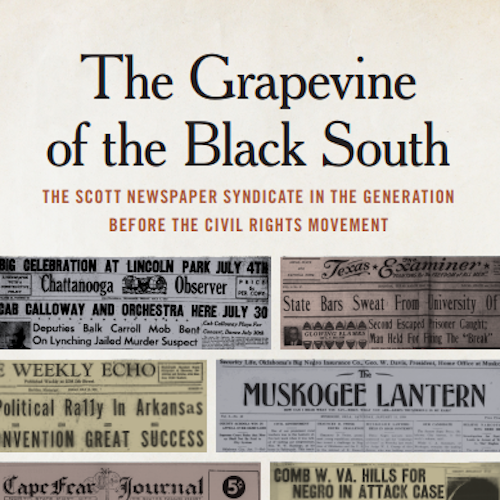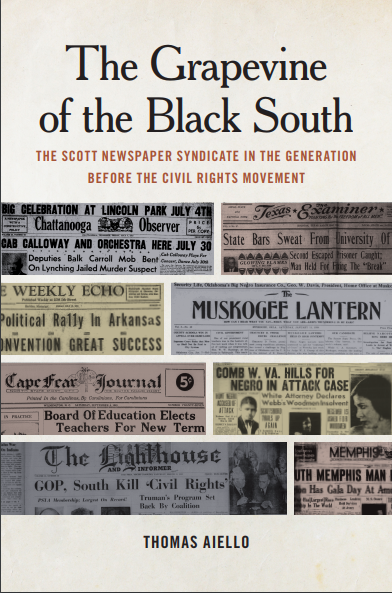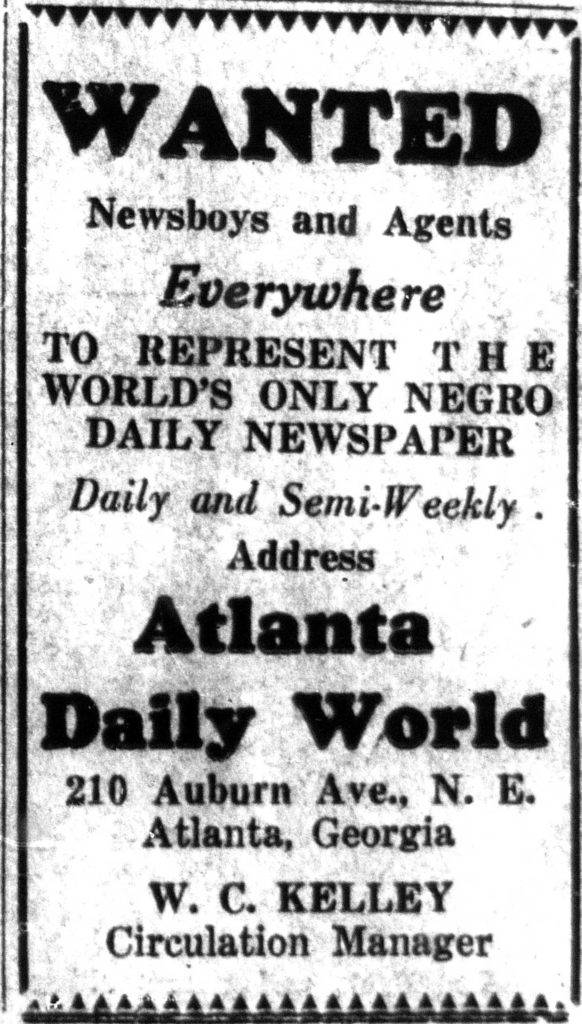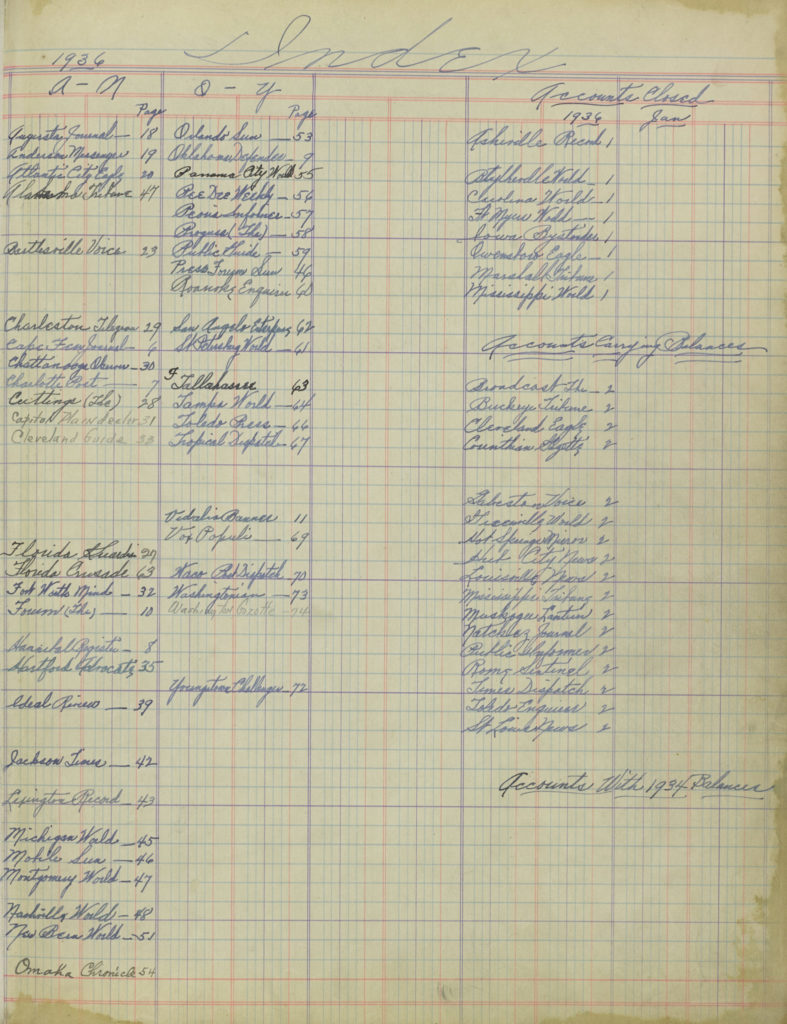In the following excerpt from the first chapter of The Grapevine of the Black South: The Scott Newspaper Syndicate in the Generation Before the Civil Rights Movement (Athens: University of Georgia Press, 2018), author Thomas Aiello recounts the origins of the Atlanta Daily World and the Scott Newspaper Syndicate on Auburn Avenue.
Excerpted from The Grapevine of the Black South: The Scott Newspaper Syndicate in the Generation Before the Civil Rights Movement by Thomas Aiello. Copyright © 2018 University of Georgia Press. Used with permission of the publisher, University of Georgia Press. All rights reserved.
W.A. Scott was a simpleton.
That’s what the veteran journalists all said. He had been a hosiery salesman, a brush salesman, an umbrella salesman. After a stint as a railroad mail clerk, he had tried his hand at publishing city directories in Jacksonville. He had come to Atlanta in 1928 to try it again.
Ric Roberts was one of the veteran journalists, the managing editor and art editor of the Mirror Publishing Company’s magazine, headquartered as were so many black businesses on Auburn Avenue. Roberts was at the soda fountain of the Yates and Milton Drug Store when the young upstart approached him. The normally brooding Scott seemed happy. “Say, Ric,” he said. “I’m going to print a newspaper.” The dreams of a simpleton. Roberts tried to explain the financial outlay required for such an endeavor, but Scott seemed unfazed. “I don’t need a lot of money. It will be a healthier way to start. I won’t waste money. I’ll use just enough to get going and then I’ll work and work and work. See? Now you make me up some headings and things and I’ll pay you just as soon as possible.” That night, Roberts set the masthead for the Atlanta World. Within two weeks, the first edition appeared.1 The new grapevine of the New South had begun to grow.
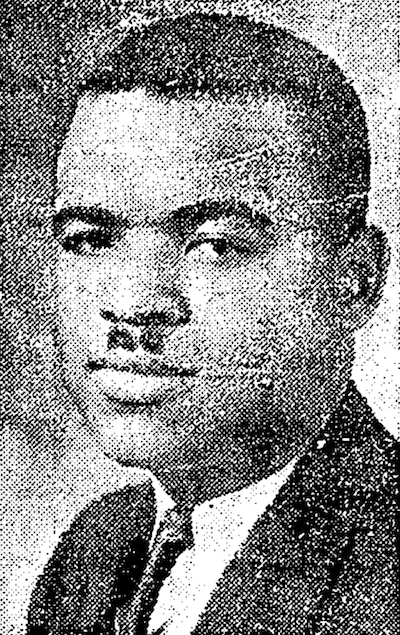
William Alexander Scott, Jr., was born on September 1, 1902 in Edwards, Mississippi, the second son of Reverend William Alexander Scott, a pastor of the Christian church, and his wife. He originally attended Edwards public schools before moving to Jackson to continue his education. His father moved to the big city to create the Ferry Street Christian Church, and in 1914, the young W.A. would be the first person baptized in the new venue. Ultimately, though, Scott would complete his secondary education at the high school department of Jackson College when he was seventeen, supplementing his work by becoming secretary to the school’s president, Z.T. Hubert. He showed an early aptitude for music and often accompanied his father to revival meetings around the state, where he would play the organ. After two years at Jackson, he transferred to Morehouse in 1925, where he was quarterback of the football team and a star on the debate team. W.A. always had a friendly rivalry with his older brother Aurelius. Aurelius went to Morehouse first, also starring on the football team and the debate team. His success is what convinced W.A. to attend, as well.2
After graduation, he moved to Birmingham, where he worked sales jobs for the Real Silk Hosiery Company, the Better Brush Company, and for Beeler Umbrellas. He was, it seemed to those closest to him, a natural born salesman. It was after this that he became a railway mail clerk for the Miami to Jacksonville run, with a home base in Jacksonville. While living in northeast Florida, he noticed a lack of cohesion among the black entrepreneurs of the city, so he published the City Business Directory of Negro Enterprises. His success with the project led him to return to Atlanta to try the same thing. He caught a fortunate break in Atlanta, finding for sale the printing equipment of the Standard Life Insurance Company.3
Early in the twentieth century, Heman Perry’s Service Printing Company began printing materials for local businesses, depending most heavily on the business of the Standard Life Insurance Company. When Standard Life folded, Service Printing tried to stay afloat by securing a loan from Citizens Trust, using its printing equipment as collateral. It turned out not to be enough, however, and Citizens Trust foreclosed. In 1925, Standard Life tried to stave off complete collapse by merging with the white Southern Insurance Company, which kept Service Printing doing its work until 1927, before its inevitable demise. The following year, Scott was able to leverage Citizens Trust’s desire to unload the equipment it found on its hands and purchased it for what historian Sadie Mae Oliver called “a very inconsiderable amount of money with payments most lenient.”4
Thus it was that Ric Roberts met W.A. Scott at the soda fountain in the summer of 1928. “In this field his alchemy has confused and irritated many of those who considered him an upstart five years ago,” explained Ric Roberts. With the help of his brother Cornelius Scott, known as C.A., he bought the Standard Life Insurance equipment, established a printing plant, and began his small four-page weekly, the first issue appearing on August 5, 1928, two short weeks after Roberts first set the masthead. He became part of the Associated Negro Press, paying twenty-five dollars for membership and two dollars per month in those early days. Scott was “trigger-brained, daring, capable and determined,” claimed editor Frank Marshall Davis, who also made the case that part of the publisher’s motivation stemmed from the success of the black press in Baltimore. Scott had “a burning bitterness toward Carl Murphy of the Afro-American newspapers,” Davis explained. Murphy and Scott were not specific rivals, but the Baltimore publisher had so many advantages that Scott never had. Murphy’s father had founded the Afro-American in 1892, the son a legacy of his father’s success. He earned degrees from Howard and Harvard, a PhD from Germany. He was an academic who served as chair of Howard’s German department until his father died in 1922 and Murphy took control of the family business. He had, in other words, everything that Scott wanted. “Scott’s main ambition was to open a newspaper plant in Washington and publish an afternoon daily for the capital and a morning paper for Baltimore,” said Davis, “which would afford him the supreme pleasure of placing a copy each a.m. on the Murphy doorstep.”5
Formed in 1919 with eighty charter member papers, the Associated Negro Press was the original twentieth century attempt at a new grapevine that would bind the new diaspora that had begun to spread throughout the country. It was the Chicago Defender, Lawrence Hogan has explained, “along with the possibilities of a national black press it exemplified, that came to serve as the catalyst for the establishment of the Associated Negro Press.”6 Emanating from Chicago under the leadership of its founder, Claude Barnett, the ANP would make the growth of the black press through World War II possible. At the same time, however, that kind of service also priced out smaller papers who could never afford such luxuries. Scott would try to fill that gap essentially by using one ANP subscription for all of the papers he eventually printed, bringing him into regular conflict with Barnett.
Scott also took the innovative step upon starting his paper of hiring agents to canvas the black community and solicit subscriptions door-to-door. It worked, and with a healthy subscription rate and relatively high circulation, Scott then had leverage to sell advertising to a wide swath of clients. “In the beginning, the paper made most of its money through its distribution,” Alexis Scott, the third-generation twenty-first century president of the paper explained. “As time went on, advertising became a more critical factor.” Davis’s Independent was there for political reasons. Scott was unconcerned with politics. He was concerned with making money, and his aggressive efforts began to bear fruit. “What the World contained was of no great interest to him,” said Frank Davis, “but how many copies were sold was of primary importance.” By 1931, large white corporations like Sears, Roebuck and Atlanta’s Rich’s department store were advertising in the World. “There was clearly a demand,” said Alexis Scott, “because the mainstream media did not cover the black community during those days of segregation.”7
In February 1930, Scott wrote to the Associated Negro Press, explaining that he was planning to publish two days a week instead of one and desiring that the service send material by special delivery rather than traditional mail to facilitate a quicker turnaround. “Do not make mention of this as a news item until we get it going,” Scott told them. 8 The year after the World became a semi-weekly, W.A. and his brother Emel entered the office of the Gary American in Gary, Indiana, while traveling north. There they met Frank Marshall Davis, to whom W.A. explained his plans for a massive newspaper chain based out of Atlanta. That chain was the Southern Newspaper Syndicate, which Scott formed in January 1931. Being that he had his own printing equipment, and understanding that the usual overhead for publishing a newspaper was cost prohibitive – as noted by historian Sadie Mae Oliver, there were “heavy charges for news service; a maintenance staff of local news gatherers and reporters; correspondents at points of pronounced activities; an adequate office force, not excluding the expensive machinery needed in securing the printed sheet” – he developed a plan to foster the ability of entrepreneurs in smaller towns and cities in the South to forego some of those expenses.9 Scott’s plant would print local newspapers and supplement local news with other material from the Atlanta World and other papers in the system. The Southern Newspaper Syndicate thus created the systematic production of news in the region. In April of that year, the World became a tri-weekly along with several of the Syndicate companion papers, among them the Chattanooga Tribune, Birmingham World, and Memphis World. That summer, the Syndicate began a rotogravure sheet, and Davis moved from Indiana to help run Scott’s growing operation. Scott had queried Claude Barnett of the Associated Negro Press about the possibility of a rotogravure section as early as December 1929. The ANP was going with a monthly sheet, while Scott had an even larger vision to publish pictures once a week. Many criticized Scott for overreaching, but he responded by reaching farther. Finally, on March 13, 1932, the World became a daily, adding “News While It is News” to its masthead in a direct statement of its value over and against black weeklies. “It marked still another epoch in the annals of this race’s journalistic endeavors,” the paper’s first daily edition announced with typical flourish.10

The Wiseacres said we were flying High when we conceived The Daily idea and put it to use. They were right. We are flying high. We print more news per week than any other plant in the World — which serves Negroes wholly.
They were flying high. The month following the World’s move to a daily, local laborer James Williams insisted that his wife stop reading the paper and go to bed. When she refused, he simply turned out the light so she couldn’t see. In the argument that followed, Williams bit his wife’s hand and she hit him four times with a hammer, leaving the back of his head severely lacerated. “When I want to read my Atlanta World,” she told a reporter before her day in court, “I want to read it, and nothing can stop me.”11
“I have been inclined to question the spreading out process of Mr. W.A. Scott’s paper development,” observed Jesse O. Thomas, Southern Field Director of the National Urban League, in February 1931. “Upon investigation however I find that it does not represent as great a financial hazard as I had supposed.” Thomas realized that all of the Scott papers “carry about the same news except for one or two inside pages” and thus seemed reasonably affordable. “I might add – he is making money,” said Thomas. “He has some 1500 subscribers in Columbus and around 2,000 in Birmingham, altho these papers are less than a month old.” Thomas’s assessment was in aid of convincing Claude Barnett that Scott’s planned rotogravure section was worth negotiations. “In the event you go into the proposition with him and find that he is falling down in any way,” Thomas assured, “I think I can whip him into line.”12
Those negotiations seemed to go well. The Syndicate had enough pictures from its member cities to fill most of the sheet, “but you might have a good picture we might want sometimes,” Scott told Barnett. “There will be no overlap of territory covered by your papers and my papers, therefore we can exchange pictures to our mutual advantage.”13
There were black daily analogues prior to the World’s arrival. The first black southern newspaper was L’Union, founded in New Orleans in 1862. It stopped publication prior to the close of the Civil War, but with its life began the full flower of black southern presses, which quickly outnumbered their northern counterparts in the decades following the war. The New Orleans Tribune became a daily in October 1864. The Baltimore Daily Evening Chronotype briefly appeared three years later, and the Columbus Daily Messenger appeared in Georgia in 1889. In the 1890s, the Negro World was published in Knoxville, Tennessee, the Daily American in Jacksonville, Florida. In the early twentieth century there was the Muskogee Searchlight in Oklahoma, the Benton Watchman in Louisiana, and the Waco Observer in Texas. Several others made brief appearances in the decade following World War I. None of the papers, however, had long shelf-lives or large circulations.14
The Atlanta Daily World, it seemed, was different. It was “the ‘ace’ accomplishment of the Georgia Negro in the business and service of journalism,” according to white commentator Asa Gordon. Such isn’t to say that it was an easy process. The paper struggled financially in its first year, constantly lagging behind in its debts to the Associated Negro Press. Overcoming such struggles was an accomplishment made all the greater, Gordon argued, along with other successes like Citizens Bank and Trust and Atlanta Life Insurance, because it happened in a period of ugly racial intransigence after World War I and the Depression that followed on its heels, which damaged the prospects for all black business in the period. The World published six editions per week for six weeks, then began publishing a Saturday paper, as well. “When you build something,” Scott said, “always build it in such a way that it will not crash if something underneath it should crack.” When the Syndicate’s reach began drifting beyond the bounds of the South in 1933, Scott changed its name to the Scott Newspaper Syndicate. “Five years ago he was an obscure hosiery salesman in Atlanta with no experience in or training for the publishing game,” wrote the New York Amsterdam News’s J.C. Chunn with a fitting sense of wonder. “At the time of his death he was the publisher of the only Negro daily in the country and the head of a syndicate.” That Syndicate owned one daily, two semi-weeklies, and printed more than fifty other weekly papers that blanketed the South and parts of the Midwest.15
It was a story of ascension, of linear progress moving a man, a family, and a community forward beyond the bounds set for them by the Jim Crow South.
When the Atlanta World first started assailing the Negro newspaper axiom of the age – Negro newspapers cannot be profitably printed more than one time per week – the rest of the newspaper world said the idea was poorly conceived, unthinkable and certain to end its protractors up in a swamp.
The World “heeded not these warnings,” one Syndicate advertisement explained. “It defied time, precedent, advice, and it is moving along nicely with its future almost completely assured.” Albert Barnett, writing in 1938, claimed that “the rise of the Scott Newspaper Syndicate” through the most pressing years of the Depression “constitutes an epic in Negro journalism.”16
Though many of the pages of the early Atlanta World were devoted to race relations, and lynching in particular, Scott knew what interested readers. The World always covered sensational crimes and provided a wide berth for sports coverage. The paper held a virtual monopoly on news of the African American community in Atlanta after the collapse of the Independent, but its scope was far larger than the city limits. Atlanta’s central place in the lives of African Americans gave the paper a national resonance, and it used that resonance to establish its broad-based newspaper syndicate throughout the South.17
“A glance backward at 1931 will show The Southern Newspaper Syndicate has accomplished what no other Negro newspaper organization ever dreamed of doing,” one advertisement boasted. “A chain of Negro newspapers published three times every week.” Then there was the rotogravure section and comics. “The publishing of news while it is news, made possible by SNS publications on a more than one-issue-a-week basis.” Then there was “full time employment for 51 well trained young Negro men and women and part time work for 500 more.” It was a legitimate achievement in so short a span. “Pardon us if we sound chesty,” the paper boasted. Its accomplishments were “a monument to Negro business and publishing life and a credit to those who have made and read the various SNS papers.”18
The various SNS papers, however, did come with attendant baggage. As early as 1930, Scott began a decades-long disagreement with Claude Barnett of the Associated Negro Press. His strategy of allowing locals to include some news copy, then have it set and printed in Atlanta, led Scott to believe that he really only needed one membership in the Associated Negro Press. Barnett, however, argued that each paper that used ANP material should be required to be part of the organization. Scott’s claim that others were the publishers, that the Syndicate was essentially just a printer, was the kind of argument he would repeat unsuccessfully in a Jackson, Mississippi libel case in the 1940s (see Chapter 5), and it continued to be a sticking point between he and Barnett. The claim helped facilitate the black press in the South by reducing costs for locals who wanted to start newspapers, but Barnett’s argument that it did so at the expense of the ANP was surely true.19
“Again,” Barnett wrote to Scott in March 1931, “without permission from us and against our rules, you have given service to other papers with you publish. This we cannot longer permit. Those papers must take out membership in order to use service.” He also made it clear that the ANP would not grant the Birmingham World membership, as the service already had a member paper in Birmingham, “which has steadfastly refused to permit the inclusion of another member.” Things hadn’t improved by June. “Let’s get straight on the whole matter,” one Barnett letter stated. “You can’t expect us to serve five papers for the price of one.” He offered the Syndicate half the normal rate for each paper as an olive branch.20
Scott responded that “there was a time that we did print occasionally as many as seven papers,” but they did so sporadically, as “they were small papers and in the experimental stage.” Because of that irregularity, they had discontinued the printing of “all individual papers under outside management” and instead just started branches of the World in other cities like Birmingham, Columbus, and beginning in late June 1931, Memphis. “You can readily see they are merely branches of the Atlanta World. At these branches we only have a circulation man and an office clerk,” Scott explained. “WE HAVE NO ADVERTISING MAN IN THESE CITIES. WE MERELY NAME THE PAPER AFTER THE TOWN IN WHICH WE START.” Columbus had lost money since its founding, he claimed. Birmingham and Memphis looked a little better, but they had yet to secure local advertising. As a counteroffer, Scott proposed the two dollar per week charge for ANP service be raised to five, two dollars for Atlanta and one for each of the Syndicate member cities. A frustrated ANP agreed to the terms.21
In November 1933, the ANP briefly discontinued service to the Syndicate for failure to pay its bills. Scott was able to restore service and delay payment, but he had continued to let the bill lapse. On February 1, 1934, the ANP gave him until March 1 to take “some decisive action on your part.”22
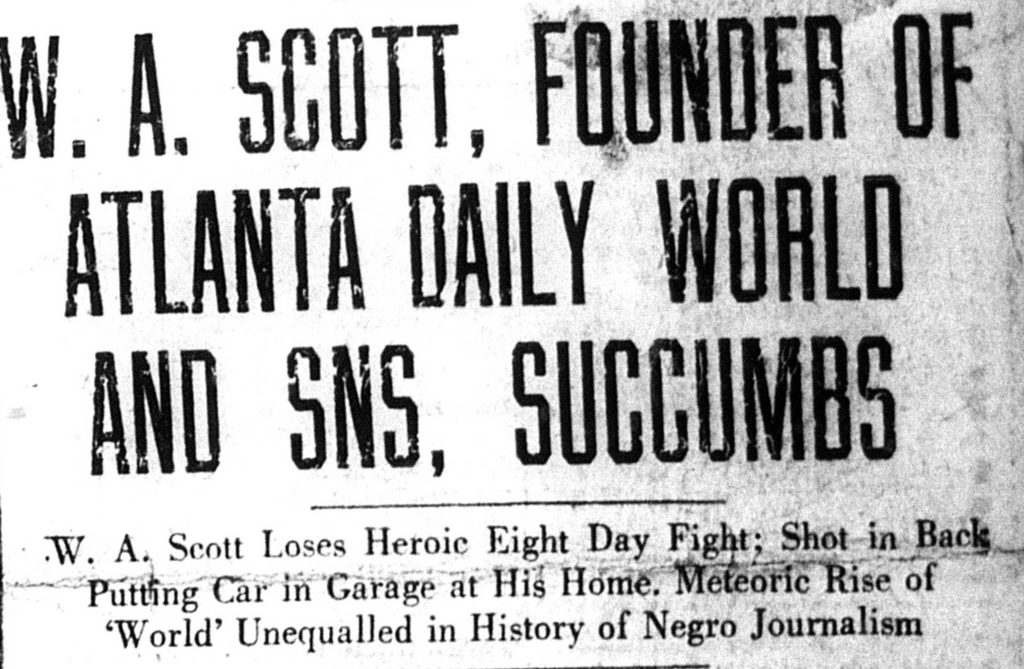
Scott would not be able to take decisive action, however, as his penchant for making enemies ultimately doomed the publisher. He was murdered in 1934 soon after the ANP’s ultimatum. “My associates here join me in sincere regret at the passing of Mr. Scott,” wrote Claude Barnett on behalf of the ANP. “He had done so much in so brief a time and possessed such courage and daring vision, that he was needed in his field. We will miss him.” But they wouldn’t forget the bill, writing again soon after about payment. Scott’s brother CA had taken over the reigns of the Syndicate and responded quickly with two weeks’ payment.23
The first edition of Scott’s Atlanta World on August 5, 1928 had opened with a declaration by its publisher titled “A Dedication to the Public,” a presentation of the paper that positioned it as a spokesperson for the disadvantaged.
That the bulk of the Negroes in the United States live in the South; that the race problem is a problem which concerns primarily the South; that if the race problem is to be solved, the men who do it will be Southern products; these are irrefragable truths alive in the minds of all thinking Negroes; these are truths which are continually manifest in the hearts of all Negroes who have a race consciousness and race pride.
That the Negro has no sectional Newspaper representative in the Southland; that the Negro is viewing his race news, such as it is – chiefly crimes of thieves and murderers – primarily through the optics of a host of prejudiced white papers which take pride in flaunting the black man as a vicious enemy to society; such are the facts brought before us in our daily contacts.
The publishers of The Atlanta World have felt the need of a Southern Negro newspaper, published by Southern Negroes, to be read by Southern Negroes. It is in a sincere effort to fill that need that The Atlanta World is being presented to the Southern public for its approval or disapproval. The responsibility of a Negro newspaper is to dispense to the public good, wholesome, information to enlighten our people of what his brother is doing; and to serve as a guide and organ of expression for matters of vital concern to the Negro.
To carry out in full faith that responsibility, we dedicate to the public this initial issue of The Atlanta World.
It was a unique manifesto, one that demonstrated that the Scotts saw their project as a decidedly southern venture, a project that would bind the black South with a grapevine of information that counteracted the misrepresentation and lack of concern by the dominant white southern press. It was a grapevine strengthened by a practical radicalism that sought to argue for rights without directly attacking those denying them. And it was poised to grow.
Cover Image Attribution: “In The Atlanta World‘s First Car,” Atlanta Daily World, February 11, 1934: 6.
Citation: Aiello, Thomas. “Atlanta, the Scott Family, and the Creation of a Media Empire.” Atlanta Studies. December 18, 2018. https://doi.org/10.18737/atls20181218.
Thomas Aiello is associate professor of history and African American studies at Valdosta State University. He is the author of Jim Crow’s Last Stand: Nonunanimous Criminal Jury Verdicts In Louisiana (LSU, 2015), Model Airplanes Are Decadent and Depraved: The Glue-Sniffing Epidemic of the 1960s (Northern Illinois, 2015), and The Battle for the Souls of Black Folk: W.E.B. DuBois, Booker T. Washington, and the Debate That Shaped the Course of Civil Rights (Praeger, 2016), among several other books.
- Atlanta Daily World, February 11, 1934, 6.[↩]
- When Aurelius was at Morehouse, he published an annual for the college’s 1925–26 school year, which have may have influenced W.A. to later enter the publishing field. Such is the influence of older brothers. Atlanta Daily World, February 11, 1934, 8; and Edward A. Jones, “Morehouse College in Business Ninety years—Building Men,” Phylon Quarterly 18, 3 (1957): 237. His father, a PhD, an educator, and a fraternal leader along with being a minister, would later move to east Tennessee, where he preached at Jonesboro, Washington, and ultimately at West Main Street Christian Church in Johnson City. His son’s membership would move there with his father, as there was no church of that denomination in Atlanta. Atlanta Daily World, February 8, 1934, 1.[↩]
- Another account has W.A., always scheming to make money, selling umbrellas one year while in school. He sold six hundred one school year, quit Morehouse, married his first wife, then moved to Florida to become a railway mail clerk on the Miami to Jacksonville line. Atlanta Daily World, February 8, 1934, 1; February 11, 1934, 6; February 12, 1934, 6; and Leonard Ray Teel, “W.A. Scott and the Atlanta World,” American Journalism 6, 3 (1989): 159–65.[↩]
- Sadie Mae Oliver, “The History and Development of the Atlanta Daily World” (MA thesis, Hampton Institute, 1942), 3. While at Morehouse, Scott took an economics course from Lorimer D. Milton, who worked for Citizens Trust, which was the receiver of the Service Printing Company following the financial demise of Heman Perry, its owner, in the mid-1920s. Though Milton claimed he never charged Scott, his family disputed that claim, arguing that he wrangled a favorable deal from Milton and Citizens Trust. John N. Ingham and Lynne B. Feldman, African American Business Leaders: A Biographical Dictionary (Westport, CT: Greenwood Press, 1994), 582.[↩]
- Atlanta Daily World, February 8, 1934, 1; February 11, 1934, 6; W.A. Scott to C.A. Barnett, August 6 1928; and Agreement, August 6, 1928, Box 148, Folder 7, The Claude A. Barnett Papers: The Associated Negro Press, 1918–1967, Part Two, Associated Negro Press Organizational Files, 1920–1966, Chicago Historical Society, Chicago, Illinois [hereinafter cited as “Barnett Papers”]; and Frank Marshall Davis, “Negro America’s First Daily,” Negro Digest 5 (1946): 86. For more on Davis, see Frank Marshall Davis, Livin’ the Blues: Memoirs of a Black Journalist and Poet (Madison: University of Wisconsin Press, 1992) and Frank Marshall Davis, Writings of Frank Marshall Davis, A Voice of the Black Press, ed. John Edgar Tidwell (Jackson: University Press of Mississippi, 2007).[↩]
- Lawrence D. Hogan, A Black National News Service: The Associated Negro Press and Claude Barnett (Hackensack, NJ: Fairleigh Dickinson University Press, 1984), 28, 56–74.[↩]
- Ingham and Feldman, African American Business Leaders, 583; and Alexis Scott interview, Family Business Radio, January 12, 2012. In possession of author.[↩]
- W.A. Scott to Associated Negro Press, February 18, 1930, Box 148, Folder 7, Barnett Papers.[↩]
- Oliver, “The History and Development of the Atlanta Daily World,” 6–7; and Ingham and Feldman, African American Business Leaders, 584.[↩]
- Atlanta Daily World, March 14, 1932, 1; February 8, 1934, 1; February 11, 1934, 6; February 12, 1934, 6; March 13, 1934, 1; W.A. Scott to C.A. Barnett, 12 December 1929, Box 148, Folder 7, Barnett Papers; and Alton Hornsby, Jr., “Georgia,” in The Black Press in the South, 1865-1979, ed. Henry Lewis Suggs (Westport, CT: Greenwood Press, 1983), 127–30. Along with news from the Syndicate and the ANP, the Scotts got photos for its rotogravure section from both of those sources, along with International News Photos, Acme Wide World, and other mainstream services. Albert G. Barnett, “Why Can’t We Have Negro Dailies?” Afro-American Youth 1 (December 1937): 4–7, reprinted in Indianapolis Recorder, January 15, 1938, 13.[↩]
- Memphis World, April 15, 1932, 2.[↩]
- Jesse O. Thomas to C.A. Barnett, February 25, 1931, Box 148, Folder 7, Barnett Papers.[↩]
- W.A. Scott to C.A. Barnett, June 23, 1931, Box 148, Folder 7, Barnett Papers.[↩]
- Gloria Blackwell, “Black-Controlled Media in Atlanta, 1960–1970” (PhD diss: Emory University, 1973), 12; Alfred McClung Lee, The Daily Newspaper in America (New York: The Macmillan Company, 1937), 177; Maria E. Odum-Hinmon, “The Cautious Crusader: How the Atlanta Daily World Covered the Struggle for African American Rights from 1945 to 1985” (PhD diss: University of Maryland, 2005), 15–16; George W. Gore, Negro Journalism: An Essay on the History and Present Conditions of the Negro Press (Greencastle, IN: DePauw University, 1922), 19–20; and Armistead Scott Pride, “A Register and History of Negro Newspapers in the United States, 1827–1950” (PhD diss: Northwestern University, 1950), 18–25.[↩]
- Gordon, The Georgia Negro, 267-268; W.A. Scott to Associated Negro Press, October 4, 1928; W.A. Scott to Associated Negro Press, October 21, 1929; W.A. Scott to Associated Negro Press, November 12, 1929; W.A. Scott to Associated Negro Press, December 30, 1929, Box 148, Folder 7, Barnett Papers; Atlanta Daily World, February 8, 1934, 1;Atlanta Daily World, February 11, 1934, 6; Atlanta Daily World, February 12, 1934, 6; Atlanta Daily World, March 13, 1934, 1; New York Amsterdam News, February 14, 1934, 1; Hornsby, Jr., “Georgia,” 127–30; Allen Woodrow Jones, “Alabama,” in The Black Press in the South, 1865–1979, ed. Henry Lewis Suggs (Westport, CT: Greenwood Press, 1983), 43; and Roland E. Wolsely. The Black Press, USA (Ames: Iowa State University Press, 1971), 73–4. As the World grew in stature and resources, it became able to send correspondents to major sporting events like Joe Louis fights or major black college football rivalries. For the most part, however, it still relied on press agents for baseball games. It also always held a membership with the Associated Negro Press, headquartered in Chicago. The paper’s physical plant covered roughly 4,000 square feet, a cramped operation to be sure. The office was in the Citizens Trust Building at 210 Auburn Avenue. Oliver, “The History and Development of the Atlanta Daily World,” 10–1, 13, 22–3.[↩]
- Atlanta Daily World, March 31, 1932, 6; and Albert G. Barnett, “Why Can’t We Have Negro Dailies?” Afro-American Youth 1 (December 1937): 4–7, reprinted in Indianapolis Recorder, 15 January 1938, 13. The expansion did take a toll on the family. “It seems as if there is about to be a rift in the ranks of the Scott family in the very near future,” reported Frank Marshall Davis, “as a matter of fact, it has already occurred to a certain extent.” Davis was never specific about “this family fuss,” but he did confide that he was frustrated enough that he was open to finding new employment in the field. Claude Barnett of the Associated Negro Press was unsurprised, “because the whole country has been wondering how they were managing to do the startling things which you are doing down that way.” It was a family strain that would continue. On June 5, 1935, L.A. Scott, one of C.A.’s brothers, arrived at the Syndicate offices drunk and in a rage, arguing with his mother Lucile and attacking employee Lucien Dupre. When Cliff McKay and John Calhoun tried to detain him, L.A. punched McKay, as well. Then he stormed off to the press itself, ripping belts from the machinery and scattering tools before again attacking Dupre. He then left, heading all the way to Bolivar, Tennessee. When he returned later that month he was arrested. Dupre had been confined to his home for four weeks as a result of the wounds he sustained at the hands of Scott. C.A. Scott to C.A. Barnett, Postal Telegraph, July 8, 1935; Associated Negro Press to C.A. Scott, July 10, 1935; C.A. Scott to Percival L. Prattis, July 12, 1935, Box 148, Folder 8; and F.M. Davis to Claude Barnett, August 9, 1931; C.A. Barnett to F.M. Davis, September 1, 1931, Box 148, Folder 7, Barnett Papers.[↩]
- Hornsby, Jr., “Georgia,” 127–8; and Ingham and Feldman, African American Business Leaders, 585–6.[↩]
- Atlanta Daily World, December 27, 1931, 3.[↩]
- Associated Negro Press to W.A. Scott, February 25, 1930, W.A. Scott to C.A. Barnett, February 28, 1930, Associated Negro Press to W.A. Scott, April 5, 1930, Associated Negro Press to W.A. Scott, July 30, 1930, Box 148, Folder 7, Barnett Papers.[↩]
- Associated Negro Press to W.A. Scott, March 2, 1931; Associated Negro Press to W.A. Scott, March 7, 1931, Box 148, Folder 7, Barnett Papers; and Associated Negro Press to W.A. Scott, June 30, 1931, Box 148, Folder 7, Barnett Papers.[↩]
- W.A. Scott to C.A. Barnett, July 4, 1931; Associated Negro Press to W.A. Scott, July 7, 1931, Box 148, Folder 7, Barnett Papers.[↩]
- Ingham and Feldman, African American Business Leaders, 581; and C.A. Barnett to F.M. Davis, November 27, 1933; Associated Negro Press to W.A. Scott, February 1, 1934, Box 148, Folder 8, Barnett Papers.[↩]
- C.A. Barnett to F.M. Davis, February 12, 1934; Associated Negro Press to C.A. Scott, February 22, 1934; Frank Marshall Davis to C.A. Barnett, February 22, 1934, Box 148, Folder 8, Barnett Papers.[↩]

